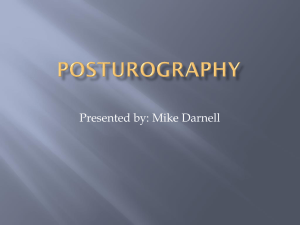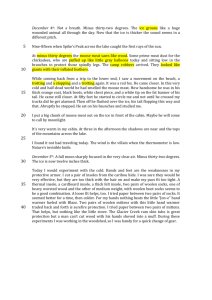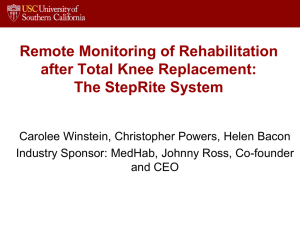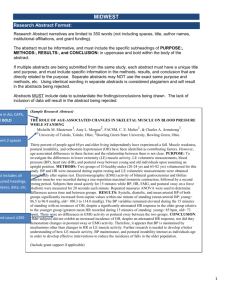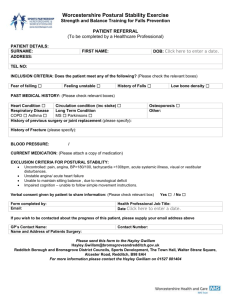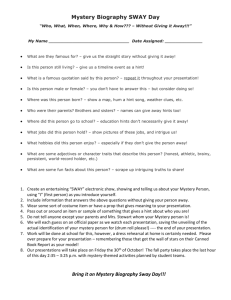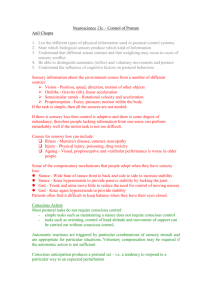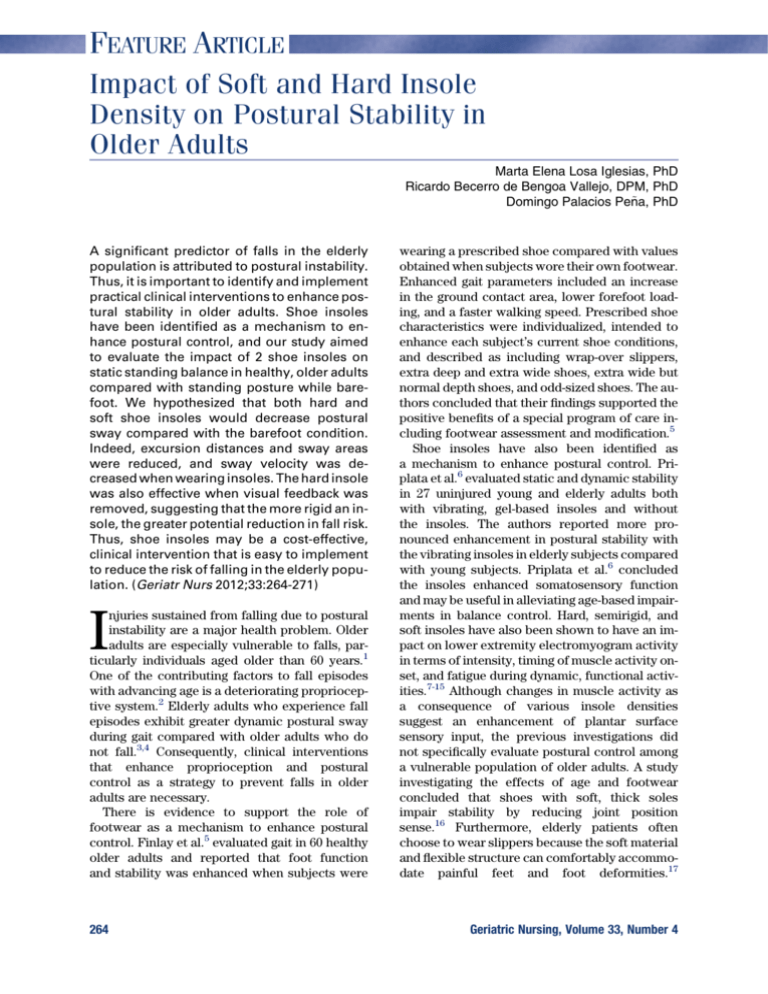
FEATURE ARTICLE
Impact of Soft and Hard Insole
Density on Postural Stability in
Older Adults
Marta Elena Losa Iglesias, PhD
Ricardo Becerro de Bengoa Vallejo, DPM, PhD
~a, PhD
Domingo Palacios Pen
A significant predictor of falls in the elderly
population is attributed to postural instability.
Thus, it is important to identify and implement
practical clinical interventions to enhance postural stability in older adults. Shoe insoles
have been identified as a mechanism to enhance postural control, and our study aimed
to evaluate the impact of 2 shoe insoles on
static standing balance in healthy, older adults
compared with standing posture while barefoot. We hypothesized that both hard and
soft shoe insoles would decrease postural
sway compared with the barefoot condition.
Indeed, excursion distances and sway areas
were reduced, and sway velocity was decreased when wearing insoles. The hard insole
was also effective when visual feedback was
removed, suggesting that the more rigid an insole, the greater potential reduction in fall risk.
Thus, shoe insoles may be a cost-effective,
clinical intervention that is easy to implement
to reduce the risk of falling in the elderly population. (Geriatr Nurs 2012;33:264-271)
njuries sustained from falling due to postural
instability are a major health problem. Older
adults are especially vulnerable to falls, particularly individuals aged older than 60 years.1
One of the contributing factors to fall episodes
with advancing age is a deteriorating proprioceptive system.2 Elderly adults who experience fall
episodes exhibit greater dynamic postural sway
during gait compared with older adults who do
not fall.3,4 Consequently, clinical interventions
that enhance proprioception and postural
control as a strategy to prevent falls in older
adults are necessary.
There is evidence to support the role of
footwear as a mechanism to enhance postural
control. Finlay et al.5 evaluated gait in 60 healthy
older adults and reported that foot function
and stability was enhanced when subjects were
I
264
wearing a prescribed shoe compared with values
obtained when subjects wore their own footwear.
Enhanced gait parameters included an increase
in the ground contact area, lower forefoot loading, and a faster walking speed. Prescribed shoe
characteristics were individualized, intended to
enhance each subject’s current shoe conditions,
and described as including wrap-over slippers,
extra deep and extra wide shoes, extra wide but
normal depth shoes, and odd-sized shoes. The authors concluded that their findings supported the
positive benefits of a special program of care including footwear assessment and modification.5
Shoe insoles have also been identified as
a mechanism to enhance postural control. Priplata et al.6 evaluated static and dynamic stability
in 27 uninjured young and elderly adults both
with vibrating, gel-based insoles and without
the insoles. The authors reported more pronounced enhancement in postural stability with
the vibrating insoles in elderly subjects compared
with young subjects. Priplata et al.6 concluded
the insoles enhanced somatosensory function
and may be useful in alleviating age-based impairments in balance control. Hard, semirigid, and
soft insoles have also been shown to have an impact on lower extremity electromyogram activity
in terms of intensity, timing of muscle activity onset, and fatigue during dynamic, functional activities.7-15 Although changes in muscle activity as
a consequence of various insole densities
suggest an enhancement of plantar surface
sensory input, the previous investigations did
not specifically evaluate postural control among
a vulnerable population of older adults. A study
investigating the effects of age and footwear
concluded that shoes with soft, thick soles
impair stability by reducing joint position
sense.16 Furthermore, elderly patients often
choose to wear slippers because the soft material
and flexible structure can comfortably accommodate painful feet and foot deformities.17
Geriatric Nursing, Volume 33, Number 4
Unfortunately, soft-soled shoes may threaten an
older person’s stability, because greater muscular activity is required to maintain such stability
when attempting to stop while walking in this
type of footwear.18
The link between postural stability and falls is
well documented, with postural stability deficits
being significant predictors of falls in older
adults.19,20 It is therefore imperative to identify
and implement practical clinical interventions to
enhance postural stability in older adults. To our
knowledge, no previous investigations have
described the effects of insole density on
standing postural stability. Therefore, the
purpose of this study was to evaluate the impact
of 2 shoe insoles on static standing balance in
healthy, older adults compared with standing
posture while barefoot. We elected to evaluate
postural sway during a barefoot rather than
a shoe condition because footwear has been
shown to affect sensory feedback, potentially
acting as a sensory filter between the feet and the
standing surface.21-23 We hypothesized that both
types of shoe insoles would decrease postural
sway compared with the barefoot condition.
Methods
Subjects
Twenty-two people participated in the study.
Subjects were randomly selected from a group
of 128 people already participating in nutritional
research studies in various nursing centers
throughout Madrid, Spain. Forty-six residents
were included in the sample criteria, were asked
to participate, and gave consent. From this population, we performed a simple random for 26
subjects (56% of total).24 Only 22 participants
decided to participate in the study.
The sample consisted of 16 healthy women and
6 men aged 77 to 91 years (age 85 years 3;
weight 138.89 lb 20; height 61.4 inches 3.6).
Any preexisting foot conditions or deformities
were noted and listed in Table 1. All subjects
were required to have normal or corrected-tonormal vision and be able to ambulate independently without an assistive device. Exclusion
criteria included any current lower-extremity
musculoskeletal disorder, uncorrected visual
deficiency, neurological disorders, diabetes mellitus, lower extremity amputation and/or prostheses, plantar ulcers, cognitive impairment as
Geriatric Nursing, Volume 33, Number 4
Table 1.
Preexisting Foot Deformities
Type of Deformity
Hallux abductus valgus
bilateral
Hallux abductus valgus
unilateral
Claw toes/hammer toe
Tailor’s bunion
Crowded toes (infraductussupraductus)
Metatarsalgia
Plantar fat pad atrophy
Nail deformity
Flat feet
Cavus feet
No. of
Patients (%)
16 (72.72)
4 (18.18)
22 (100)
5 (22.72)
7 (31.81)
10 (45.45)
15 (68.18)
22 (100)
15 (68.18)
2 (9.09)
determined by a Short Portable Mental Status
Questionnaire score \7,25 and the failure to
meet all inclusion criteria.
The study protocol conformed to the guidelines set forth in the Declaration of Helsinki. Informed consent was obtained from all subjects
before their participation in the study, which
was approved by the Ethics Committee of the
Universidad Rey Juan Carlos.
Instrumentation
Balance was evaluated using tests of postural
sway and coordinated stability using a digital
portable force plate (EPS-Platform; Loran Engineering, Castel Maggiore, Bologna, Italy). The
platform dimensions were 48 3 48 cm with
a thickness of 5 mm and also had a ruler and gridlines that were used as markers to ensure the feet
were placed in the same position for all tests. The
platform included 2,304 resistive sensors, allowing for accuracy of measurements to be to the
nearest 0.01 kPa. Data were recorded at a frequency of 60 Hz, and the platform was linked to
a personal computer containing the datacollection software program Foot Checker, version 4.0 for Windows (Loran Engineering, Castel
Maggiore, Bologna, Italy).
Procedures
All subjects completed 3 testing sessions in
a laboratory setting with a minimum of external
265
distractions. The same testing procedures were
repeated during each session, with 1 week between sessions. The gridlines, an important feature of the platform, allowed us to measure the
location of the heels, toes, separation of heels,
and separation of toes to accurately repeat the
foot placement for each patient the following
week. Postural sway was assessed as subjects
stood on a force platform in a natural standing position with their arms by their side. During the first
testing session, postural sway was assessed while
subjects were barefoot. In the second testing session, subjects wore a gel soft insole (SoftSock
Foot Support, Addison, TX), with a .25-inch solid
gel bottom. During third and final testing, subjects
wore a hard insole sock (Shore value A50, Algeos
Ltd., Liverpool, United Kingdom), with a .25-inch
smooth ethylene vinyl acetate surface.
For each condition, 3 trials of 30 seconds’
length each were performed, and data were collected as subjects assumed a bilateral stance during each trial. Each task was performed with eyes
both open and closed. To control for possible variations in visual field during the eyes-open condition, subjects were asked to focus on a target
positioned 2 meters in front of them at eye level.
If the person moved or lost his or her balance, the
data were discarded, and the trial was repeated
until data were obtained with the person remaining still. Aside from these instances, no “practice
trials” were permitted.
Data Analysis
For each testing condition, data were managed
in the following manner. The first 10 seconds of
each trial was discarded.26,27 The remaining 20
seconds from each of 3 trials were then
averaged, and the average was used for
subsequent analysis.26-28 Postural sway was
evaluated using a group of measures. Center of
pressure (COP; millimeters) was calculated
along the medial-lateral and anterior-posterior
axes. Sway area (SA; in square millimeters) was
calculated using an elliptical area measure generated by the software; distance of the sway area
(DSA; millimeters) and the sway velocity (SV)
(mm/sc) were also calculated. SV was evaluated
along
both
the
anterior-posterior
and
medial-lateral axes. Limits of stability were based
on the maximum excursion (mm) obtained
across trials and included anterior excursion
(AE), posterior excursion (PE), medial excursion
266
(ME), and lateral excursion (LE). Finally, the
Romberg Index was calculated for sway area
(RISA), sway velocity (RISV), and the distance
of the sway area (RIDSA) using the following
equation: (eyes closed/eyes open) * 100. Thus,
a value of zero would represent no difference between visual conditions.29
Normal distribution of the data set was evaluated with statistical testing including the
Kolmogorov-Smirnov test. A repeated-measure
analysis of variance was used to compare sole inserts used over time in the data analysis. Tukey
adjustment was applied for the multiple pairwise comparisons between standing conditions:
barefoot, soft insole, and hard insole conditions.
Interaction between the standing condition and
postural stability (eyes open or closed) was also
examined. The difference between eyes open
and closed was tested with the interaction considered. Statistical significance was established
at P \ .05 using 95% confidence intervals. All
data analysis was conducted with commercially
available software (SPSS version 14.0; SPSS
Science, Chicago, IL).
Results
Kolmogorov-Smirnov tests indicated that all
data were normally distributed.
When evaluating postural sway by visual field
conditions, there were significant differences as
subjects were barefoot for DSA (P 5 .022), SV
(P 5 .020), and SA (P 5 .026; Table 2). In each instance, values were greater during the eyesclosed condition compared with eyes open.
When subjects wore the gel insole, there were significant differences across visual fields for AE
(P 5 .044), DSA (P 5 .017), and SA (P 5 .021;
Table 2). In each instance, values were again
greater during the eyes-closed condition compared with eyes open. When subjects wore the
hard insole, there were significant differences
across visual fields for AE (P 5 .009), PE (P 5
.018), ME (P 5 .041), and COP along the y axis
(P 5 .001; Table 2). Anterior excursion was
greater during the eyes-closed compared to
eyes-open condition. Excursion in the posterior
and medial planes was greater, however, during
the eyes open condition. Finally, COP along the
y axis was posteriorly oriented during the eyesopen condition and anteriorly oriented with the
eyes closed while wearing the hard insole.
Geriatric Nursing, Volume 33, Number 4
.197
.131
.032
.550
.108
.003
.609
.605
.515
.048
.044
.031
.546
.078
.0003
.182
.153
.261
.009
2.55 1.97
4.11 3.39
.191
5.02 2.43
3.68 2.51
.494
5.60 4.75
3.07 2.28
.422
4.94 4.60
5.51 4.70
.277
0.36 4.42
1.14 2.56
.012
1.45 2.32
0.42 2.07
.013
68.13 28.77
76.35 45.92
.027
2.27 0.95
2.54 1.53
.007 7391.65 2861.58 8320.51 4898.16
Statistical significance: P \ .05.
AE 5 anterior excursion; CE 5 closed eyes; COP 5 center of pressure; DSA 5 distance of the sway area in millimeters; LE 5 lateral excursion; OE 5 open eyes; ME 5 medial
excursion; PE 5 posterior excursion; SA 5 sway area; SV 5 sway velocity.
P
.862
2.38 2.06
4.44 5.94
.466
4.65 2.79
3.78 2.52
.546
3.20 1.84
3.77 2.94
.514
5.64 4.50
4.88 3.72
.653
1.31 2.97
0.38 2.87
.314
1.20 2.29
0.90 1.90
75,38 48,22
.010
61.80 30.95
.005
2.08 1.01
2.51 1.60
.038 7012.34 30 4094.30 9275.25 6277.81
P
CE
(Mean ± SD)
OE
(Mean ± SD)
CE
(Mean ± SD)
OE
(Mean ± SD)
AE (mm)
3.01 2.05
3.05 2.08
PE (mm)
4.78 3.83
5.26 4.60
ME (mm)
3.80 3.15
3.29 2.46
LE (mm)
6.16 6.01
5.54 4.85
COP, x axis (mm)
1.41 4.88
1.03 2.52
COP, y axis (mm)
0.63 1.85
1.14 2.29
DSA (mm)
69.77 38.21
85.75 54.65
2.32 1.27
2.87 1.81
SV (mm2)
7695.30 4199.53 9425.09 5887.00
SA (mm2)
P
P
Value for
Interaction
CE
(Mean ± SD)
OE
(Mean ± SD)
Hard Insole
Soft Insole
Barefoot
Comparison of Postural Sway with Eyes Open and Closed Across Standing Conditions
Table 2.
Geriatric Nursing, Volume 33, Number 4
When evaluating the Romberg Index, sway area
was not significantly different when comparing
the barefoot and hard insole conditions
(P 5 .321) but was significant when comparing
the gel and hard insole conditions (P 5 .022;
Table 3). In both instances, indices were lower
when subjects wore the hard insole (Table 3).
There was no significant difference in the Romberg Index for sway area when comparing the
barefoot and gel insole conditions (Table 3).
There were also no differences for the Romberg
Index for sway velocity or the distance of the
sway area when comparing barefoot, gel, and
hard insole conditions (Table 3).
When comparing postural control across standing conditions with the eyes open, there were significant differences in ME (P 5 .016) when comparing
the gel and hard insole conditions (Table 4). In each
instance, values were greater when the hard insole
was worn compared with the gel insole condition.
There were also differences approaching significance in COP along the x axis when comparing
the barefoot and gel insole standing conditions
(P 5 .059), because there was greater posterior
excursion while subjects were barefoot. There
were no other significant differences across standing conditions with the eyes open (Table 4).
When comparing postural control across standing conditions with the eyes closed, there were
significant differences in PE (P 5 .044), COP
along the y axis (P 5 .041), and approaching significance in SV (P 5 0.054) when comparing the
barefoot and gel insole conditions (Table 5). In
each instance, values were higher in the barefoot
compared with gel insole condition. There were
also significant differences in AE (P 5 .028), PE
(P 5 .029), and COP along the y axis (P 5 .007)
when comparing the barefoot and hard insole
standing conditions (Table 5). Excursion was
greater anteriorly when the hard insole was
worn and greater posteriorly during the barefoot
condition. Center of pressure along the y axis was
greater and oriented posteriorly during the barefoot condition compared with a smaller, anterior
orientation during the hard insole condition.
There were no significant differences in postural
control with the eyes closed when comparing the
gel and hard insole conditions (Table 5).
Discussion
The maintenance of postural stability is dependent on a range of somatosensory inputs. Tactile
267
sensitivity within the foot has a strong influence
on maintenance of postural stability, as evidenced when this sensory input is lost in diabetic
neuropathy.30,31 Furthermore, vision has
a definitive role in postural control.31,32 Elderly
persons are often unable to take advantage of
the reinsertion of proprioception when vision is
not available. Reintegration of proprioception
under a no-vision scenario yielded a faster COP
speed for elderly persons compared with young
adults.29 Shoe insoles can increase plantar foot
surface contact and potentially increase somatosensory input. Therefore, this investigation evaluated the impact of soft and hard shoe insoles on
postural control in the elderly during static standing posture during both eyes open and eyes
closed conditions. We hypothesized that both insoles would result in a more stable standing posture compared with standing barefoot. The
results from this study confirmed this hypothesis,
because excursion distances and sway areas
were smaller and sway velocity was slower
when wearing insoles compared with barefoot
standing. These changes in postural stability promoted positioning of the center of mass and displacement within the base of support. Thus,
shoe insoles may be a cost-effective, easyto-implement clinical intervention to reduce fall
risk in a vulnerable population.
Removing visual sensory input places a greater
demand on tactile feedback to maintain postural
stability. It was therefore not surprising to detect
pronounced changes in postural sway when
subjects stood with their eyes closed compared
with standing with their eyes open. Standing
with eyes closed in both the barefoot and soft insole conditions resulted in a more unstable standing posture, as values for sway area, distance of
sway area, and sway velocity were all greater
than in the eyes open condition. Additionally,
excursions along the anterior axis were also
greater when subjects stood on the soft insole
with their eyes closed compared with standing
with their eyes open. Although standing on the
hard insole with the eyes closed also yielded
greater anterior excursion compared with eyes
open, posterior excursion, medial excursion,
and center of pressure translation along the y
axis were all lower. Although the mechanism underlying improvements with the eyes closed is
not clear, we do believe these results are supportive of using a hard insole as an effective means to
enhance postural stability in a challenging
environment.
There were improvements in postural sway for
both insole conditions compared with barefoot
standing. These differences were modest for the
soft insole and only evident when visual feedback
was removed; posterior excursion and the distance of the sway area were both lower during
the soft insole standing condition. Significant enhancement in postural sway was evident during
the hard insole standing condition compared
with barefoot standing. These differences included a lower Romberg Index for sway area,
small center of pressure values along the x axis
with the eyes open and smaller anteriorposterior excursions and center of pressure
values along the y axis with the eyes closed.
When comparing insoles, the hard insole yielded
a lower Romberg Index for sway area, whereas
the soft insole yielded lower values for medial excursion and the distance of the sway area when
the eyes were open. There were no differences
in postural sway between the insoles when the
eyes were closed.
Because the hard insole was effective in promoting postural sway when visual feedback was
removed and when compared with the barefoot
standing condition, we suggest a more rigid insole
Table 3.
Romberg Index
RISA
RISV
RIDSA
Barefoot
(Mean ± SD)
Soft Insole
(Mean ± SD)
Hard Insole
(Mean ± SD)
Barefoot/Soft
Insole P Value
Barefoot/Hard
Insole P Value
Soft/Hard
Insole P Value
1.14 0.67
0.94 0.09
1.23 0.35
1.45 1.29
0.94 0.09
1.19 0.30
0.87 0.14
0.91 0.09
1.11 0.33
.396
.964
.839
.321
.567
.128
.022
.415
.339
Statistical significance: P \ .05.
RIDSA 5 Romberg Index Distance of the Sway Area; RISA 5 Romberg Index Sway Area; RISV 5 Romberg Index Sway
Velocity.
268
Geriatric Nursing, Volume 33, Number 4
Geriatric Nursing, Volume 33, Number 4
Table 4.
Postural Control Across Standing Conditions with Eyes Open
AE (mm)
PE (mm)
ME (mm)
LE (mm)
COP, x axis (mm)
COP, y axis (mm)
DSA (mm)
SV (mm/sg)
SA (mm2)
Barefoot
(Mean ± SD)
Soft Insole
(Mean ± SD)
Hard Insole
(Mean ± SD)
Barefoot/Soft
Insole P Value
Barefoot/Hard
Insole P Value
Soft/Hard
Insole P Value
3.01 2.05
4.78 3.83
3.80 3.15
6.16 6.01
1.41 4.88
0.63 1.85
69.77 38.21
2.32 1.27
7695.30 4199.53
2.38 2.06
4.65 2.79
3.20 1.84
5.64 4.50
1.31 2.97
1.20 2.29
61.80 30.95
2.08 1.01
7012.34 30 4094.30
2.55 1.97
5.02 2.43
5.60 4.75
4.94 4.60
0.36 4.42
1.45 2.32
68.13 28.77
2.27 0.95
7391.65 2861.58
.506
.976
.748
.811
.992
.546
.183
.245
.548
.731
.923
.088
.321
.059
.287
.927
.926
.887
.929
.825
.016
.680
.115
.883
.336
.429
.829
Statistical significance: P \ .05.
AE 5 anterior excursion; COP 5 center of pressure; DSA 5 distance of sway area; ME 5 medial excursion; OE 5 open eyes; PE 5 posterior excursion; LE 5 lateral excursion;
SA 5 sway area; SV 5 sway velocity.
Table 5.
Postural Control Across Standing Conditions with Eyes Closed
AE (mm)
PE (mm)
ME (mm)
LE (mm)
COP, x axis (mm)
COP, y axis (mm)
DSA (mm)
SV (mm/sg)
SA (mm2)
Barefoot
(Mean ± SD)
Soft Insole
(Mean ± SD)
Hard Insole
(Mean ± SD)
Barefoot/Soft
Insole P Value
Barefoot/Hard
Insole P Value
Soft/Hard Insole
P Value
3.05 2.08
5.26 4.60
3.29 2.46
5.54 4.85
1.03 2.52
1.14 2.29
85.75 54.65
2.87 1.81
9425.09 5887.00
4.44 5.94
3.78 2.52
3.77 2.94
4.88 3.72
0.38 2.87
0.90 1.90
75.38 48,22
2.51 1.60
9275.25 6277.81
4.11 3.39
3.68 2.51
3.07 2.28
5.51 4.70
1.14 2.56
0.42 2.07
76.35 45.92
2.54 1.53
8320.51 4898.16
.337
.044
.760
.678
.520
.041
.338
.054
.983
.526
.029
.941
.999
.979
.007
.272
.141
.402
.940
.982
.555
.705
.407
.779
.989
.977
.504
Statistical significance: P \ .05.
AE 5 anterior excursion; COP 5 center of pressure; DSA 5 distance of sway area; ME 5 medial excursion; OE 5 open eyes; PE 5 posterior excursion; LE 5 lateral excursion;
SA 5 sway area; SV 5 sway velocity.
269
may be a more effective orthotic intervention than
a soft orthosis as a strategy to reduce fall risk. This
finding is consistent with previous investigations
in which it was determined that soft-soled shoes
may threaten an older person’s stability, because
greater muscular activity is required to maintain
stability during a stopping motion while wearing
this type of footwear.18 One of the proposed
mechanisms underlying the effectiveness of orthotics and insoles in the enhancement of postural stability is an improvement in kinesthetic
awareness.33 An orthotic cradles the foot and
can promote a more neutral alignment of the talocrural joint. This can facilitate efficiency in muscle contractile performance, thereby potentially
improving muscular contributions to ankle joint
stability.33 Placing the foot in a more neutral position as a mechanism underlying improved postural stability is also supported by a study
reporting lower frontal-plane center of pressure
length and velocity measures in 15 healthy subjects when an orthotic medial rearfoot post was
used.34 The improvement in stability was hypothesized to be a consequence of limiting the range of
foot pronation. A hard insole is more likely to be
corrective and promote a neutral foot position,
because a soft insole is designed to accommodate
foot posture. Thus, we suggest that the hard insole
may be a more effective intervention than a soft
insole for reducing fall risk in the elderly.
Findings from this study are consistent with
previous reports that foot orthosis intervention
improves postural stability. Ochendorf et al.33
evaluated the influence of ankle muscle fatigue
and custom-made, semirigid orthotic use on postural sway in healthy male subjects. The authors
reported that after fatigue, the nonorthotic condition yielded greater sway values than orthotic
condition. Rome and Brown35 balance was improved in 20 healthy male subjects with excessively pronated feet when they used a rigid foot
orthosis compared with a group that had no orthotic intervention. Olmstead and Hertel36 evaluated postural in 30 individuals with different foot
types. They reported improvements with semirigid orthotic use among individuals with a cavus
foot structure. Our study differed from previous
reports in using a soft insole and evaluating an
older population. Although the mechanisms contributing to improved postural stability across investigations may not be consistent, collectively
the findings support the use of insoles and orthotics to improve postural control.
270
One limitation of this study was the use of the
same testing order, which could introduce bias
into the study. Further research is needed with regard to the order of testing to potentially better
counterbalance across conditions. We evaluated
a spectrum of postural sway variables. We did
note improvements in stability in some, but not
all, of these variables. At this time, we are not
aware of which parameters may be predictive of
fall risk. Furthermore, although improvements in
postural sway were noted with the use of insoles,
it is not clear whether they will actually decrease
the risk of falling. Prospective, longitudinal studies will be necessary to determine which postural
stability variables are useful in predicting fall risk
and if the use of shoe insoles are an effective intervention for fall prevention. Finally, we did not collect direct measures of sensory and motor
function. Thus, this study cannot provide direct insight to the mechanisms underlying improvements in postural stability as a consequence of
the insole intervention.
Conclusion
There were significant improvements in postural sway when subjects stood on both soft
and hard insoles compared with standing barefoot, with more pronounced improvements
when a hard insole was used. Providing increased
sensory inputs with hard insoles may be an inexpensive and effective way to reduce fall risk in
older adults.
References
1. Sanchez GR, Fernandez RM, Alfonso FM, et al. Falls in
the elderly. General considerations and prevention. Rev
Cubana Med Gen Integr 1999;15:98-102.
2. Tideiksaar R. Falls in the elderly. Bull N Y Acad Med
1988;64:145-63.
3. Bergland A, Wyller TB. Risk factors for serious fall
related injury in elderly women living at home. Inj Prev
2004;10:308-13.
4. Stephen R, Sherringron S, Menz H, et al. Falls in older
people: risk factors and strategies for prevention. 2nd ed.
Cambridge, MA: Cambridge University Press; 2007.
5. Finlay O, van de Meer D, Beringer T. Use of gait analysis
to demonstrate benefits of footwear assessment in
elderly people. Physiotherapy 1999;85:451-6.
6. Priplata AA, Niemi JB, Harry JD, et al. Vibrating insoles and
balance control in elderly people. Lancet 2003;362:1123-4.
7. Bird AR, Bendrups AP, Payne CB. The effect of foot
wedging on electromyographic activity in the erector
Geriatric Nursing, Volume 33, Number 4
8.
9.
10.
11.
12.
13.
14.
15.
16.
17.
18.
19.
20.
21.
22.
23.
24.
spinae and gluteus medius muscles during walking. Gait
Posture 2003;18:81-91.
Hatton AL, Dixon J, Martin D, et al. The effect of textured
surfaces on postural stability and lower limb muscle
activity. J Electromyogr Kinesiol 2009;19:957-64.
Hertel J, Sloss BR, Earl JE. Effect of foot orthotics on
quadriceps and gluteus medius electromyographic
activity during selected exercises. Arch Phys Med
Rehabil 2005;86:26-30.
Kulig K, Burnfield JM, Reischl S, et al. Effect of foot
orthoses on tibialis posterior activation in persons with
pes planus. Med Sci Sports Exerc 2005;37:24-9.
Mundermann A, Wakeling JM, Nigg BM, et al. Foot
orthoses affect frequency components of muscle activity
in the lower extremity. Gait Posture 2006;23:295-302.
Murley GS, Bird AR. The effect of three levels of foot
orthotic wedging on the surface electromyographic
activity of selected lower limb muscles during gait.
Clinical biomechanics (Bristol, Avon) 2006;21:1074-80.
Nawoczenski DA, Ludewig PM. Electromyographic
effects of foot orthotics on selected lower extremity
muscles during running. Arch Phys Med Rehabil 1999;80:
540-4.
Tomaro J, Burdett RG. The effects of foot orthotics on
the EMG activity of selected leg muscles during gait. J
Orthop Sports Phys Ther 1993;18:532-6.
Vanicek N, Kingman J, Hencken C. The effect of foot
orthotics on myoelectric fatigue in the vastus lateralis
during a simulated skier’s squat. J Electromyogr Kinesiol
2004;14:693-8.
Robbins S, Waked E, McClaran J. Proprioception and
stability: foot position awareness as a function of age and
footwear. Age Ageing 1995;24:67-72.
Munro BJ, Steele JR. Household-shoe wearing and
purchasing habits. A survey of people aged 65 years and
older. J Am Podiatr Med Assoc 1999;89:506-14.
Perry SD, Radtke A, Goodwin CR. Influence of footwear
midsole material hardness on dynamic balance control
during unexpected gait termination. Gait Posture 2007;
25:94-8.
Rubenstein LZ, Josephson KR. The epidemiology of falls
and syncope. Clin Geriatr Medicine 2002;18:141-58.
Stalenhoef PA, Diederiks JP, Knottnerus JA, et al. A risk
model for the prediction of recurrent falls in communitydwelling elderly: a prospective cohort study. J Clin
Epidemiol 2002;55:1088-94.
Arnadottir SA, Mercer VS. Effects of footwear on
measurements of balance and gait in women between the
ages of 65 and 93 years. Phys Ther 2000;80:17-27.
Mundermann A, Stefanyshyn DJ, Nigg BM. Relationship
between footwear comfort of shoe inserts and
anthropometric and sensory factors. Med Sci Sports
Exerc 2001;33:1939-45.
Waddington G, Adams R. Textured insole effects on
ankle movement discrimination while wearing athletic
shoes. Phys Ther Sport 2000;1:119-28.
Epidemiological Analysis of Tabulated Data (EPIDAT).
Pan American Health Organization. World Health
Geriatric Nursing, Volume 33, Number 4
25.
26.
27.
28.
29.
30.
31.
32.
33.
34.
35.
36.
Organization (WHO). Health Situation Analysis Program
(SHA). Washington, DC 20037-2895, U.S.A. (1998).
Pfeiffer E. A short portable mental status questionnaire
for the assessment of organic brain deficit in elderly
patients. J Am Geriatr Soc 1975;23:433-41.
Le Clair K, Riach C. Postural stability measures: what to
measure and for how long. Clin Biomech 1996;11:176-8.
Raymakers JA, Samson MM, Verhaar HJ. The assessment
of body sway and the choice of the stability parameter(s).
Gait Posture 2005;21:48-58.
Menz HB, Latt MD, Tiedemann A, et al. Reliability of the
GAITRite walkway system for the quantification of
temporo-spatial parameters of gait in young and older
people. Gait Posture 2004;20:20-5.
Gagey P, Weber B, eds. Posturologıa. Regulaci
on y
alteraciones de la bipedestaci
on. Barcelona: Masson; 2001.
Gutierrez EM, Helber MD, Dealva D, et al. Mild diabetic
neuropathy affects ankle motor function. Clin Biomech
2001;16:522-8.
Simoneau G, Ulbrecht J, Derr J, et al. Role of the
somatosensory input in the control of human posture.
Gait Posture 1995;3:115-22.
Teasdale N, Simoneau M. Attentional demands for
postural control: the effects of aging and sensory
reintegration. Gait Posture 2001;14:203-10.
Ochsendorf DT, Mattacola CG, Arnold BL. Effect of
orthotics on postural sway after fatigue of the plantar
flexors and dorsiflexors. J Athl Train 2000;35:26-30.
Hertel J, Denegar CR, Buckley WE, et al. Effect of
rearfoot orthotics on postural sway after lateral ankle
sprain. Arch Phys Med Rehabil 2001;82:1000-3.
Rome K, Brown CL. Randomized clinical trial into
the impact of rigid foot orthoses on balance
parameters in excessively pronated feet. Clin Rehabil
2004;18:624-6.
Olmstead LC, Hertel J. Influence of foot type and
orthotics on static and dynamic postural control. J Sport
Rehabil 2004;13:54-66.
MARTA ELENA LOSA IGLESIAS, PhD, is a Professor in the
Facultad de Ciencias de la Salud, Universidad Rey Juan
Carlos, Alcorcon (Madrid), Spain. RICARDO BECERRO DE
BENGOA VALLEJO, DPM, PhD, is a Professor at the Escuela
Universitaria Enfermer
ıa, Fisioterapia y Podolog
ıa, Facultad de Medicina, Universidad Complutense de Madrid,
~ PhD, is a Professor in
Spain. DOMINGO PALACIOS PENA,
the Facultad de Ciencias de la Salud, Universidad Rey Juan
Carlos, Alcorcon (Madrid), Spain.
None of the authors has a financial or personal relationship
with people or organizations that could inappropriately
influence the work described in this article.
0197-4572/$ - see front matter
Ó 2012 Mosby, Inc. All rights reserved.
doi:10.1016/j.gerinurse.2012.01.007
271

